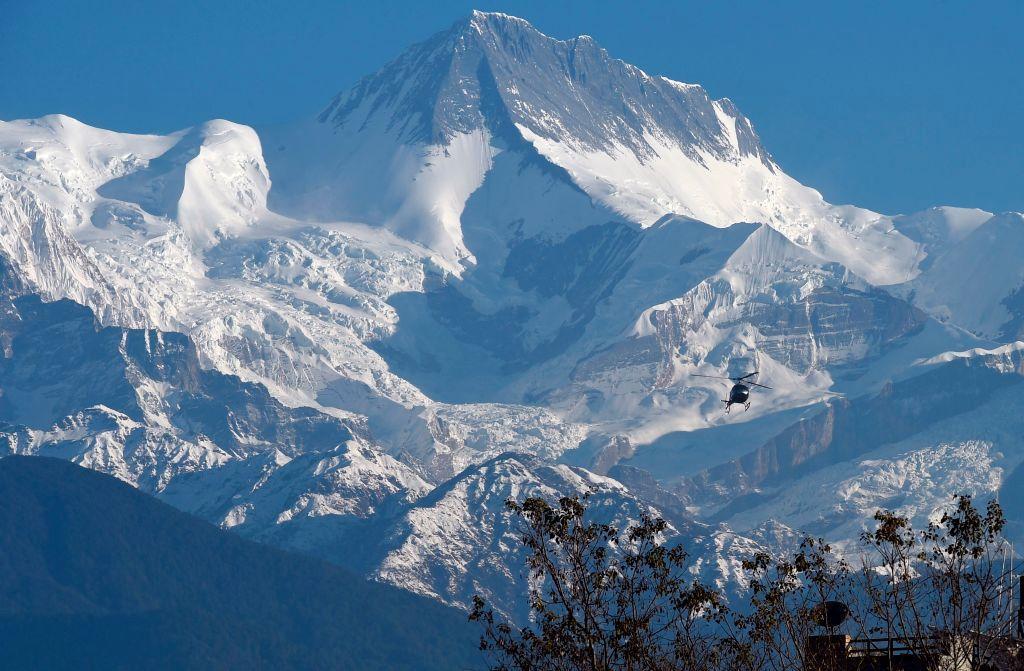
This is the final part of our series about Air Zermatt. In Part 2 we discussed pilot development and its image as a “good neighbor” in the area.
An Air Zermatt team performed the highest helicopter rescue in history: the April 29, 2010, rescue of a three-person team (two mountaineers from Spain and one from Romania) from 23,000 ft. on Annapurna, one of the world’s most challenging peaks to climb.
Air Zermatt’s Daniel Aufdenblatten (pilot) and Richard Lehner (para-rescueman) received an emergency call and hurried to come to the aid of mountaineers, even though it was not even certain that a rescue at such an altitude was possible at that time.
The rescue required three attempts to successfully retrieve the three mountaineers from the grasp of certain death. For this extraordinary achievement, the rescuers were awarded the Aviation Week Laureate “Heroism Award” on March 8, 2011, one of the most prestigious international awards in aviation.
Based in part upon the tremendous experience of its crews, Air Zermatt has developed the Air Zermatt Training Center, which offers internationally accredited courses in the fields of preclinical emergency medicine and rescue to doctors, paramedic personnel, mountain rescuers, mountain guides, rescue specialists of public safety agencies and pilots from other alpine countries.
The flight school offers type ratings in the Airbus H125 (AS350 B3), H130 T2, SA 315B Lama, H135 T3 and Bell 429. It also offers the Swiss Mountain Rating according to Swiss national law, the commercial pilot license, night rating and sling load training according to European Union Aviation Safety Agency (EASA) requirements.
Air Zermatt’s Mountain Emergency Medicine course is focused on the needs of the rescue personnel aboard the helicopter and allows graduates to achieve the international qualification for Mountain Emergency Medicine for Emergency Physicians or Paramedics, certified by the International Commission for Alpine Rescue (ICAR), International Society for Mountain Medicine (ISMM) and the International Mountaineering and Climbing Federation (UIAA.)
The Mountain Emergency Medicine course begins by covering helicopter procedures including tactics, dynamic hoisting and long line, with hovering and long-line training sessions at the heliport before practicing at a high-altitude location later in the day.
Day two covers movements on glaciers, improvised crevasse rescues with pulley systems and rescues with the tripod.
The third day begins with avalanche search-and-rescue skills including practice with avalanche transceivers, probing, shoveling and advanced life support for recovery of an avalanche victim.
The High-Altitude Medicine block is followed by a night SAR exercise and winter survival on the mountain.
Rigorous exercise follows on the fourth day with a mountaineering ski tour at elevations over 4,000 meters with a medical evacuation scenario from a nearby prominent peak.
Rescues Becoming More Dangerous Due to Warmer Temperatures
Experienced mountain guides who lead tourists up the daunting Matterhorn are growing concerned about the increased safety risks caused by warmer temperatures.
Just a few weeks after our visit, a 24-year-old British climber was hit by falling rock and fell 300 meters.
Not long afterward (on July 24, 2019), an experienced guide and his client plunged to their deaths following a rock fall on the infamous east wall of the Matterhorn. The east wall is well-known for its 1,000-meter vertical face composed of rotten rock.
Due to the heightened risk of falling rocks, recovery of the two mountaineers was difficult. In the evening, the rescuers were picked up by an Air Zermatt helicopter and transported to the precarious east wall.
Hans-Rudolf Keusen, a geologist and expert on natural hazards at the Swiss Alpine Club, says that rising temperatures are very probably a factor in the increased risk from rock falls and thinks conditions are becoming too dangerous in summer above 2,500 meters.
Permafrost is thawing at ever-higher altitudes, leading to an increase in rock falls.
Switzerland’s Institute for Snow and Avalanche Research analyzed permafrost temperatures from over 154 boreholes in a variety of regions throughout the Swiss Alps.
Also participating in the project was the Swiss permafrost monitoring network PERMOS. For 20 years, PERMOS has been documenting the state and changes of mountain permafrost in the Swiss Alps.
Temperatures were measured at over 10 meters depth in the ground where seasonal fluctuations are minimal and temperature changes indicate long-term trends. The warming of mountain permafrost can impair the stability of buildings in high alpine regions as well as steep mountain slopes.
Decreased stability of steep mountain slopes and the increased risk from falling rocks create additional risk for the mountaineering guides and their clients. Given these trends, Air Zermatt’s rescue expertise will be called upon even more in the future.
Air Zermatt’s Worldwide Reach
What started as an innovative idea by a municipal councilman concerned with providing humanitarian rescues in the alpine environment has evolved into a company that provides expedited patient care for transit to higher levels of medical care.
The innovations by this respected Swiss rescue organization have aided patients needing care not only in remote Swiss alpine locations, but worldwide.
Finally, this author extends a special thank you to our hosts at Air Zermatt. This special visit provided lifelong learning lessons for the lucky group of students who participated in the tour.






Comments